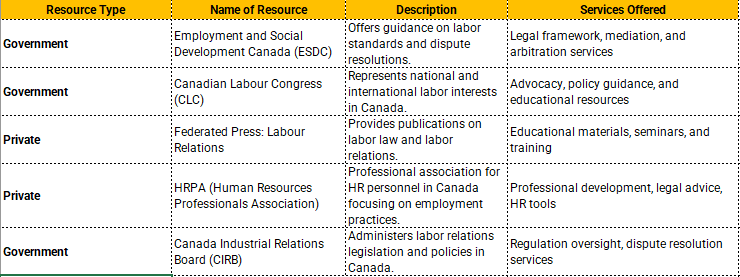In an era where the pulse of the Canadian economy beats stronger than ever, businesses across the nation face myriad challenges that test their endurance and flexibility. Among these, labor disputes and strikes stand out as significant events that can disrupt the smooth flow of operations, impacting everything from the bottom line to customer relationships and employee morale. Understanding and preparing for such occurrences are not just about crisis management; it’s about safeguarding the continuity of business operations in a landscape marked by competitive pressures and regulatory complexities.
Strike contingency planning in Canada is more than a reactive measure; it’s a proactive strategy that businesses employ to navigate the choppy waters of labor disputes with minimal disruption. This planning is crucial, given the unique interplay between Canadian labor laws, the rights of workers, and the obligations of employers. It involves a detailed mapping of potential risks, communication strategies, operational adjustments, and legal compliance measures, all tailored to the distinct Canadian context.
The significance of such planning cannot be overstressed. For businesses, the repercussions of a strike or labor dispute extend beyond immediate financial losses. They touch upon the very reputation of the company, its relationship with its workforce, and its standing within the broader community. In today’s fast-paced economic environment, where news travels faster than ever, and consumer expectations are at an all-time high, maintaining operational integrity and public trust during times of internal strife is paramount.
Moreover, the landscape of labor relations in Canada is dynamic, shaped by evolving laws, the shifting priorities of the workforce, and the ever-changing demands of the global market. This makes strike contingency planning an ongoing process, rather than a one-off preparation, requiring businesses to stay informed, flexible, and ready to adapt to new challenges.

The Canadian Labor Landscape
In Canada, the terrain of labor laws and union activities forms a complex ecosystem that businesses must navigate with care and understanding. The relationship between employers, employees, and unions is governed by a set of laws and regulations that aim to balance the needs and rights of all parties involved. This equilibrium is crucial for maintaining a healthy work environment and ensuring the smooth operation of the country’s economy.
At the heart of Canada’s labor landscape is the principle of collective bargaining, a process through which unions and employers negotiate terms of employment. This process is a cornerstone of labor relations in Canada, reflecting the country’s commitment to fairness and dialogue. However, when negotiations reach an impasse, strikes or labor disputes can arise, posing significant challenges for businesses.
The potential for labor disputes makes it essential for companies to understand not only the legal framework in which they operate but also the trends and statistics that characterize labor movements in Canada. Over the past decade, the number of strikes has fluctuated, influenced by various factors including economic conditions, sector-specific issues, and changes in labor legislation.
Recent trends show a notable shift in the nature of labor disputes, with an increasing focus on issues such as job security, working conditions, and wage increases. These disputes not only highlight the evolving priorities of the workforce but also signal the need for businesses to adapt their strategies to meet these changing demands.
Understanding these dynamics is crucial for businesses operating in Canada. By keeping a finger on the pulse of the labor landscape, companies can better prepare for potential disputes, minimizing their impact on operations, reputation, and financial health. This preparation begins with a clear understanding of Canada’s labor laws, the role of unions, and the recent trends in labor disputes, setting the stage for effective strike contingency planning.
The Nuances of Strike Contingency Planning in Canada
In Canada, where the landscape of labor laws and union relationships is as diverse as its geography, understanding strike contingency planning is not just beneficial—it’s a necessity for businesses aiming to thrive amidst labor disputes. This essential strategy enables organizations to maintain operations, uphold customer satisfaction, and protect their reputations when faced with the possibility of a strike.
At its core, strike contingency planning is a proactive measure, designed to prepare businesses for the unexpected. It’s a blueprint that outlines how operations can continue with minimal disruption, ensuring that a company remains resilient in the face of labor disputes. But in Canada, this planning takes on additional layers of complexity due to the country’s specific legal frameworks and the strong presence of unions.

Canadian labor laws provide a structured process for labor disputes, including clear guidelines on how and when strikes can occur. This legal environment creates a unique setting for strike contingency planning. Businesses must navigate these regulations carefully, ensuring their plans are not only effective but also compliant with the law. This involves understanding the rights and obligations of both employers and employees under the Canada Labour Code or respective provincial labor laws, depending on the jurisdiction.
Moreover, the role of unions in Canada cannot be understated. With a significant portion of the Canadian workforce unionized, especially in sectors like manufacturing, education, and public service, engaging with unions becomes a critical aspect of contingency planning. This engagement is not about preparing for battle but fostering a dialogue that can prevent disputes from escalating to strikes. Effective contingency planning in Canada, therefore, includes strategies for negotiation and mediation, aiming to find mutual ground before a conflict leads to a work stoppage.
The planning process itself begins with a thorough risk assessment, identifying critical functions and roles that would be most affected by a strike. From there, businesses develop strategies to maintain these essential operations, which may include cross-training employees, identifying alternative suppliers, or even temporarily relocating certain functions. Communication also plays a pivotal role, both in terms of internal strategies to keep employees informed and engaged, and external tactics to manage customer expectations and maintain public trust.
In essence, strike contingency planning in Canada is more than just a set of emergency procedures. It’s a comprehensive approach that considers the legal, social, and economic facets unique to the Canadian context. By incorporating these considerations into their planning, businesses can not only withstand the storm of a strike but emerge with their operations, reputations, and relationships intact.
Your Blueprint for Effective Strike Contingency Planning in Canada
When Canadian businesses face the prospect of labor disputes, having an effective strike contingency plan is not just prudent; it’s imperative for ensuring the wheels of operation continue to turn smoothly. Strike contingency planning in Canada involves a multifaceted approach, taking into account the unique legal landscape, operational continuity, and the importance of maintaining open lines of communication.
Risk Assessment and Management: A Canadian Perspective
The cornerstone of any strike contingency plan starts with a thorough risk assessment. Canadian businesses need to identify critical operations that would be most affected in the event of a strike and evaluate the potential impact on services and products. This involves a deep dive into operational vulnerabilities, prioritizing areas such as supply chain management, customer service, and logistics. Understanding these risks allows businesses to develop tailored strategies that mitigate impact, ensuring they are not caught off guard.
Clear Skies Ahead: Communication is Key
Maintaining clear and effective communication channels during a labor dispute is essential. This includes not just internal communication with employees who may not be participating in the strike, but also external communication with customers, suppliers, and the media. Crafting a communication plan that outlines how and when to communicate during a strike can help manage expectations and maintain trust. For instance, timely updates about the status of operations and any changes to services or deliveries can help in managing customer expectations and safeguarding the company’s reputation.
Operational Continuity: Keeping the Lights On
Ensuring operational continuity is another critical component of strike contingency planning. This might involve cross-training employees to cover essential roles or identifying alternative production methods or suppliers. For some Canadian businesses, exploring the possibility of temporary staffing or outsourcing certain functions could be a viable option. The aim is to maintain as much normalcy as possible, minimizing disruptions to operations and service delivery.

Legal Considerations and Compliance
Navigating the legal landscape during a labor dispute in Canada requires careful planning. Businesses must ensure compliance with Canadian labor laws, including the legal rights of workers to strike. This includes understanding the obligations under collective bargaining agreements and any potential legal ramifications of strike-breaking actions. A checklist of legal compliance can serve as a valuable tool, ensuring businesses remain on the right side of the law while protecting their interests.
In crafting a strike contingency plan, Canadian businesses must take a comprehensive approach that addresses risk management, communication, operational continuity, and legal compliance. By preparing for potential labor disputes in advance, businesses can position themselves to manage the challenges more effectively, maintaining operations and protecting their reputation in the process. This preparation not only helps in navigating the stormy waters of a strike but also strengthens the resilience of the business for any future challenges.
Rolling Out the Plan A Smooth Implementation of Your Strike Contingency Strategy
When the groundwork for a strike contingency plan has been laid, the focus shifts to implementing this strategy effectively within the organization. This step is crucial for Canadian businesses facing the prospect of labor disputes, ensuring minimal disruption to operations and maintaining the trust of employees, customers, and stakeholders. Here, we delve into the best practices for executing your strike contingency plan, emphasizing the importance of preparedness, flexibility, and clear communication.
Preparation is Key
Before a strike even appears on the horizon, businesses must ensure that all elements of their contingency plan are not only in place but also well understood by everyone in the organization. This includes comprehensive training sessions for management and staff on their roles and responsibilities during a strike. Simulated strike scenarios can be particularly effective, providing a realistic practice run that can highlight potential weaknesses in the plan or areas that require further clarification.
Ensuring Seamless Communication
Clear, transparent communication stands as one of the pillars of successful strike contingency implementation. Establishing dedicated channels for internal and external communications before a strike occurs can significantly reduce confusion and misinformation. Internally, regular updates about the situation and any expected actions from staff should be communicated through emails, intranet posts, or briefings. Externally, customers and suppliers need to be informed about how the strike may affect them and what measures are being taken to minimize any negative impact.
For external communications, preparing template messages or press releases in advance can save valuable time and ensure a consistent message is conveyed to the public and media. These templates can be quickly customized to fit the specifics of the current situation, providing timely and accurate information to those affected.

Flexibility and Adaptability
No plan, no matter how well crafted, can account for every possible outcome. As such, flexibility and adaptability are essential traits during the implementation phase. Businesses must be ready to adjust their strategies in response to the evolving dynamics of a strike. This could mean reallocating resources to different departments, adjusting operational hours, or even negotiating temporary agreements with unions or employees to keep critical functions running.
Monitoring the situation closely allows businesses to respond to changes effectively. Establishing a dedicated team or task force to oversee the implementation of the contingency plan can provide a centralized point of decision-making and coordination. This team should be empowered to make swift decisions and adjust strategies as needed, based on real-time information and feedback from key stakeholders.
Post-Implementation Review
After the strike has ended and normal operations resume, conducting a thorough review of the strike contingency plan’s implementation is invaluable. This review should identify what worked well, what didn’t, and why, providing insights that can be used to strengthen the plan for future use. Gathering feedback from employees, customers, and other stakeholders who were affected by the strike and the contingency measures can offer diverse perspectives on the plan’s effectiveness and areas for improvement.
By adhering to these best practices, Canadian businesses can ensure that their strike contingency plans are not just well-designed but also well-executed. The aim is not only to navigate through the strike with minimal disruption but also to emerge on the other side with the business’s integrity, operations, and relationships intact. This proactive and strategic approach to handling labor disputes underscores a business’s resilience and commitment to its employees, customers, and long-term success.
Tech Tools for Navigating Labor Disputes
The advent of digital tools and platforms has revolutionized how companies prepare for, manage, and recover from such challenging situations. This section delves into the technology strategies that can aid Canadian businesses in maintaining continuity and effective communication throughout the course of a labor dispute.
Digital Communication Platforms
Clear and consistent communication is the cornerstone of effective strike contingency planning. Digital communication platforms, such as internal messaging apps, email newsletters, and dedicated strike information websites, enable businesses to keep their employees, customers, and other stakeholders informed in real-time. These tools are not just about broadcasting updates; they also facilitate a two-way dialogue, allowing for feedback, questions, and concerns to be addressed promptly. The use of encrypted messaging apps can ensure that sensitive information remains secure, while social media platforms can be used to manage public perception and relay official company statements.
Operational Continuity Tools
Cloud-based services and software solutions allow businesses to maintain critical operations even when physical access to workplaces is restricted. Document sharing platforms, virtual meeting software, and project management tools enable teams to collaborate effectively from diverse locations. For industries where remote work is not feasible, such as manufacturing or retail, technology can still play a role. Advanced planning software can help reroute logistics and manage inventory to minimize disruption, while customer relationship management (CRM) systems ensure that customer service can continue unhindered.
Monitoring and Management Software
During a labor dispute, it’s crucial for businesses to have a real-time overview of how the situation is evolving and the impact it’s having on operations. Software that monitors social media and news outlets can provide valuable insights into public sentiment and the spread of information. Similarly, internal monitoring tools can track the productivity and engagement of remote workers, identifying potential bottlenecks or issues before they escalate. This data can be invaluable in adjusting strategies and resources on the fly to ensure the business remains agile and responsive.
Employee Training and Engagement Platforms
Preparing for a labor dispute involves ensuring that all employees are aware of their roles and responsibilities during such an event. Online training modules and digital handbooks can be rapidly updated and distributed to provide staff with the latest information and protocols. Gamification and interactive elements can increase engagement and retention of this crucial information. Furthermore, digital platforms can be used to conduct anonymous surveys and gather feedback from employees, providing a safe space for voicing concerns or suggestions.
The Future of Strike Contingency Planning
As technology continues to advance, so too does the potential for its application in strike contingency planning. Artificial intelligence (AI) and machine learning algorithms could predict the likelihood of labor disputes before they arise, offering businesses a crucial window for preparation. Blockchain technology might secure communications and transactions, ensuring transparency and trust between employers and employees. The possibilities are vast, and Canadian businesses that stay at the forefront of these technological advancements will be better equipped to navigate the complexities of labor relations.
In conclusion, integrating technology into strike contingency planning offers Canadian businesses a robust framework for maintaining operations, ensuring clear communication, and managing the myriad challenges that labor disputes present. By leveraging digital tools and platforms, companies can not only survive but thrive, even in the face of significant labor disruptions.

Moving Forward After the Dust Settles
The aftermath of a strike can feel like waking up the day after a storm. The skies are clear, but the evidence of the tumult remains. For businesses in Canada, navigating the post-strike landscape is as much about repairing and rebuilding as it is about reflection and learning. This phase is crucial not only for immediate recovery but also for fortifying the business against future disruptions.
Recovery Steps
The first step in the recovery process involves a comprehensive assessment of the strike’s impact on the business. This includes evaluating financial losses, disruptions to operations, and any damage to customer relationships or the company’s public image. It’s a time for honesty and, sometimes, hard truths.
Re-establishing normal operations is the next priority. This might involve ramping up production, rescheduling delayed services, or replenishing inventory. It’s also a time to reconnect with employees, customers, and suppliers. Transparent communication about recovery efforts and timelines can help rebuild trust and confidence.
For employees returning to work after a strike, a warm welcome can smooth over residual tensions. This might include debriefing sessions to address concerns, clarify any changes, and discuss the way forward. It’s an opportunity to reinforce the value of each employee to the organization and recommit to a positive, collaborative work environment.
Analyzing the Impact
Analyzing the strike involves more than tallying financial losses. It’s about understanding why the strike happened, how it was managed, and what could be done better. This analysis should be comprehensive, covering everything from the effectiveness of the strike contingency plan to the quality of communication with all stakeholders.
One useful approach is to convene a cross-functional team to review the strike’s timeline, actions taken, and outcomes. This team can identify what worked well and where gaps in planning or execution may have occurred. The goal is not to assign blame but to learn and improve.
Key questions to consider include:
- Were there early warning signs that were missed?
- How effective were the communication strategies with employees, customers, and the public?
- Were alternative operational strategies effective in maintaining business continuity?
- How well did the business comply with legal obligations?
- What can be done to prevent future strikes or reduce their impact?
- Rebuilding Relationships
- A strike can strain or even sever relationships between management and employees, as well as with unions. Rebuilding these relationships requires time, effort, and sincerity. Open dialogue, acknowledging grievances, and working together to address underlying issues can foster a healthier, more cooperative work environment.
Engagement doesn’t stop with employees and unions. Customers, suppliers, and the broader community may also need reassurance. Demonstrating a commitment to fair labor practices, operational excellence, and community involvement can help repair and strengthen these external relationships.
The Path to Resilience
The post-strike period is an opportunity for growth. By applying the lessons learned, businesses can enhance their strike contingency planning, improve labor relations, and increase operational resilience. Investing in employee engagement, continuous improvement, and proactive communication can transform the challenges of today into the strengths of tomorrow.
In the end, the goal is not just to recover from the strike but to emerge stronger, more united, and better prepared for the future. This journey, while not without its challenges, can lead to a more robust and resilient business, ready to face whatever comes next with confidence and grace.
The Support Network for Canadian Businesses During Labor Disputes
When it comes to labor disputes and strike contingency planning, Canadian businesses are not left to navigate the choppy waters alone. There exists a robust network of resources and support designed to help companies prepare for, manage, and recover from strikes. This network spans government agencies, private sector consultants, and industry associations, each offering unique insights, tools, and assistance to ensure businesses can maintain operations and safeguard their interests during labor conflicts.
Government Resources and Assistance
The Canadian government provides several resources aimed at helping businesses understand their obligations and rights under the country’s labor laws. The Canada Industrial Relations Board (CIRB) is a key player, offering guidance on dispute resolution and the legal framework governing industrial relations in Canada. Additionally, Employment and Social Development Canada (ESDC) offers resources on labor standards, health and safety requirements, and other essential aspects of employment law that are crucial for businesses to comply with during a dispute.
Professional Services and Consultants
A range of private sector consultants specialize in labor relations and strike contingency planning. These experts offer personalized advice, strategic planning assistance, and negotiation services to help businesses effectively prepare for and respond to labor disputes. They can provide tailored solutions based on a company’s specific industry, size, and operational needs, ensuring that businesses have a customized plan that addresses their unique challenges and objectives.
Industry Associations
Industry associations play a pivotal role in supporting businesses during labor disputes. These organizations often offer their members access to specialized information, workshops, and seminars on labor relations and dispute management. By leveraging the collective experience and knowledge of their industry, businesses can gain insights into best practices and strategies that have proven effective in similar situations. Furthermore, associations often facilitate networking opportunities, allowing companies to share experiences and solutions that can be beneficial in navigating labor disputes.
Digital Tools and Platforms
In today’s digital age, a variety of online tools and platforms can assist businesses in strike contingency planning. These include cloud-based communication systems that ensure seamless interaction with employees and stakeholders, project management software that helps maintain operational continuity, and digital platforms for legal compliance tracking. Utilizing these tools can significantly enhance a company’s ability to manage the complexities of a labor dispute while maintaining a focus on business operations.
Leveraging the Support Network
To make the most of these resources, Canadian businesses should proactively engage with government agencies, consultants, and industry associations well before a labor dispute arises. Establishing relationships and understanding the available support mechanisms can expedite the development and implementation of effective strike contingency plans. Additionally, staying informed about the latest digital tools and platforms can empower businesses to maintain agility and resilience in the face of labor challenges.
Essential Resources for Strike Contingency Planning in Canada










